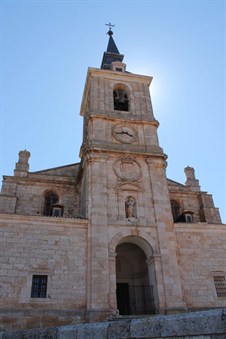Ventosilla, the Plaza de San Pablo and the Casa de la Ribera
 Riding on horseback, and in particular hunting were the favorite pastimes of Philip III. His innate skill and great physical strength made him, according to the unanimous opinion of the witnesses of the time, a great rider. The Duke of Lerma, as Caballerizo mayor, was always at the side of the ruler on such occasions and was able to make the most of this passion of the king to strengthen his ties with him and away from possible contenders to his favour. Indicative of this strategy was the hunting lodge of VentosillaVentosilla is a town located in the Comunidad Autónoma de Castilla y León, in the province of Burgos. A vestige of the most illustrious phase of its past, during the reign of Philip III, is the Posada de Ventosilla, a Renaissance style palace built for the king by his favourite, the Duke of Lerma, not far from Valladolid. Lerma reconverted the territory which had been recently acquired in the area to plant a forest and import animals, so as to ensure to Philip III a safe place and away from prying eyes in which to indulge his main passion. In addition to extensive hunting, Lerma even procured his master a building in which to reside in Valladolid, at the same time guaranteeing abundant economic gain: the palace belonged to the Count of Benavente, located on the western side of the Plaza de San Pablo, purchased and renovated by the Duke at his own expense and then sold to the king for a sum close to 200,000 ducats, equivalent to almost twice the amount of the costs incurred by the valido in previous months. A short distance from the Plaza de San Pablo Lerma also acquired the Casa de la Ribera, a large estate on the banks of the Pisuerga river. It not only constituted a more secure place to ensure entertainment for himself and the sovereign, but was also a stage on which he could show his skills as a perfect organizer of Baroque feasts and ceremonies. Tournaments, juegos de cañas and bullfights usually took place in the estate, while the magnificent gardens, adorned with statues and fountains, reflected the typically Baroque taste of the court of the Duke of Lerma. (photo: the façade of the Colegiata de San Pedro in Lerma).
Riding on horseback, and in particular hunting were the favorite pastimes of Philip III. His innate skill and great physical strength made him, according to the unanimous opinion of the witnesses of the time, a great rider. The Duke of Lerma, as Caballerizo mayor, was always at the side of the ruler on such occasions and was able to make the most of this passion of the king to strengthen his ties with him and away from possible contenders to his favour. Indicative of this strategy was the hunting lodge of VentosillaVentosilla is a town located in the Comunidad Autónoma de Castilla y León, in the province of Burgos. A vestige of the most illustrious phase of its past, during the reign of Philip III, is the Posada de Ventosilla, a Renaissance style palace built for the king by his favourite, the Duke of Lerma, not far from Valladolid. Lerma reconverted the territory which had been recently acquired in the area to plant a forest and import animals, so as to ensure to Philip III a safe place and away from prying eyes in which to indulge his main passion. In addition to extensive hunting, Lerma even procured his master a building in which to reside in Valladolid, at the same time guaranteeing abundant economic gain: the palace belonged to the Count of Benavente, located on the western side of the Plaza de San Pablo, purchased and renovated by the Duke at his own expense and then sold to the king for a sum close to 200,000 ducats, equivalent to almost twice the amount of the costs incurred by the valido in previous months. A short distance from the Plaza de San Pablo Lerma also acquired the Casa de la Ribera, a large estate on the banks of the Pisuerga river. It not only constituted a more secure place to ensure entertainment for himself and the sovereign, but was also a stage on which he could show his skills as a perfect organizer of Baroque feasts and ceremonies. Tournaments, juegos de cañas and bullfights usually took place in the estate, while the magnificent gardens, adorned with statues and fountains, reflected the typically Baroque taste of the court of the Duke of Lerma. (photo: the façade of the Colegiata de San Pedro in Lerma).
